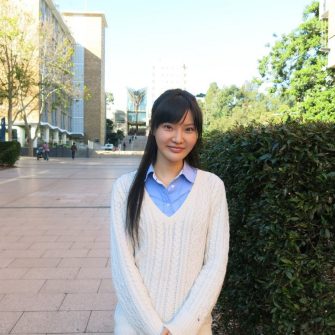
Dr Joanna Wang
Lecturer
Dr Joanna Wang is a lecturer in Statistics in the School of Mathematics and Statistics. She also has an appointment with Transport and Road Safety (TARS) Research. Dr Wang talks about what kindled her interest in statistics, her research into helmet safety and why statistics is 'sexy'.
Interview conducted by School Communications Officer, Susannah Waters
When did you first become interested in mathematics and statistics?
That would be back in high school. First it was because I had always been good at maths. The topic I like the most is in fact geometry where I can just sit down for hours trying to solve a problem. I first became interested in statistics in first year university because in high school, the statistics was quite elementary and we don’t get that much idea of what statistics is all about. That might be one of the reasons why many high school graduates don’t want to study statistics. It’s only when I came to university that I could see what statistics is all about and to see a wide range of applications where we can use statistical methods.
Did you always know you would teach and be involved in research?
Ideally I always wanted to teach and research at the same time. When I applied for this position I thought it was a research only position, and it turned out to be a joint appointment with the School of Maths and Stats where I’m required to teach large classes. So I guess I got exactly what I wanted.
Where were you working before you came to the School?
This is actually the first full time job I have had. Before I came to UNSW, I was doing my PhD at the University of Sydney where I was working as a tutor and research assistant.
Tell me a bit about the course you currently teach.
I’m currently teaching a statistics course for second year engineering students. We teach students how to apply various graphical and data analysis methods for summarising and extracting useful information from data. And more importantly, how to apply various statistical methods for drawing conclusions and making decisions in an engineering context. What’s challenging in this course is to think of ways to make statistics interesting and relevant to engineering students so that they actually see statistics is used in their discipline.
You are currently working with Dr Jake Olivier on research around helmet safety. What interests you most about this research?
It is the practical application of statistics in a very important area and the potential to influence government policy making. Mandatory helmet legislation has been around for about 20 years and yet there are still debates around the effectiveness of helmets in decreasing head injuries. Hopefully our research can answer some of those questions, and we can extend and develop a general statistical framework for assessing the effectiveness of certain policy decisions by analysing relevant data using various statistical methods.
Google’s Chief Economist, Hal Varian, has said: "I keep saying that the sexy job in the next 10 years will be statisticians. And I’m not kidding." Do you agree?
Totally. Why? Because we have data EVERYWHERE, particularly digital data. We live in a world where almost everything can be measured and monitored. But the problem is whether we have the analytical ability to make use of that large amount of data. We need to be able to visualise the data, understand the data and communicate what we find from data analysis, and that’s what statisticians do. That is why I think statisticians are increasingly in demand. The image of the profession has also changed from a bunch of people doing number crunching and producing pretty plots, to those using useful powerful computers and applying sophisticated mathematical models. I guess that’s sexy and cool!
What reactions do you get from people when you tell them what you do for work?
When I tell people that I’m a statistician, the first reaction I get is ‘what do statisticians do?’ I guess to most people it is still not so clear what statisticians do, maybe apart from calculating the average from some numbers. So I think it’s our job to show the wider community what statistics is and how statistical principles can be applied in many different disciplines.
What is your favourite part of your job at UNSW?
The good combination of teaching and research I guess. This is the first time I have done lecturing and I was quite nervous about it at the beginning; it is challenging to engage students but I find it very rewarding. It’s also an excellent working environment here, my colleagues are very helpful and inspiring. You feel you are not just doing your job in your office by yourself, there are always people who are there you can discuss ideas with, whether it’s the teaching or research aspects.
---------------
July 2013
